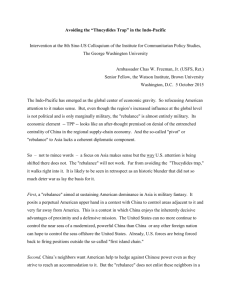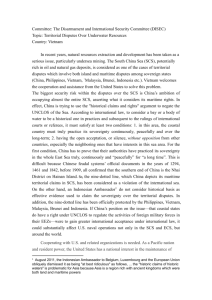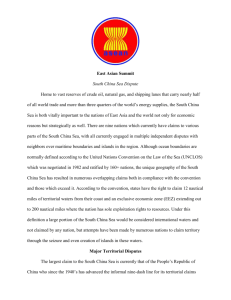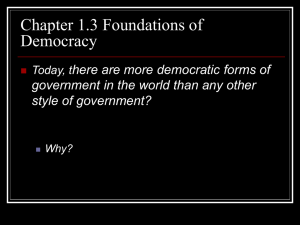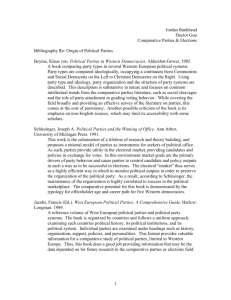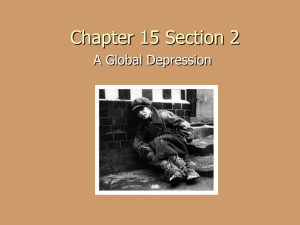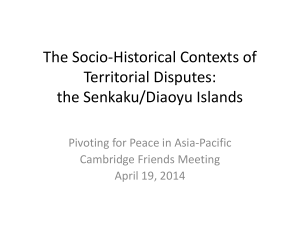Beyond Territorial Contiguity: Issues at Stake in Democratic
advertisement
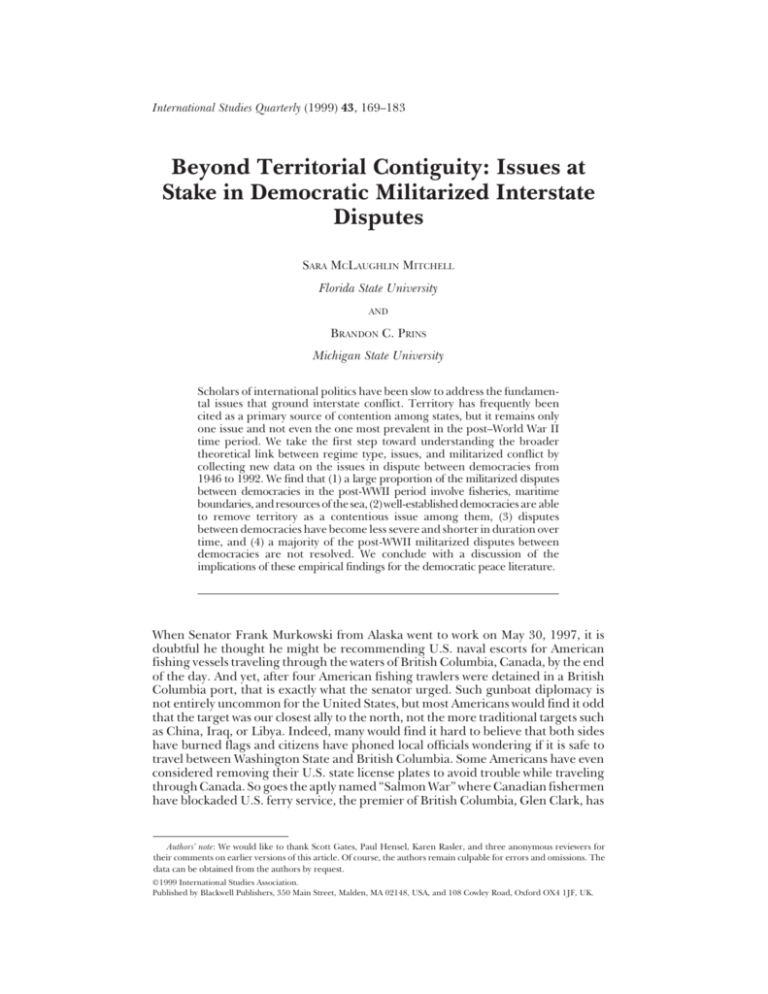
International Studies Quarterly (1999) 43, 169–183 Beyond Territorial Contiguity: Issues at Stake in Democratic Militarized Interstate Disputes SARA MCLAUGHLIN MITCHELL Florida State University AND BRANDON C. PRINS Michigan State University Scholars of international politics have been slow to address the fundamental issues that ground interstate conflict. Territory has frequently been cited as a primary source of contention among states, but it remains only one issue and not even the one most prevalent in the post–World War II time period. We take the first step toward understanding the broader theoretical link between regime type, issues, and militarized conflict by collecting new data on the issues in dispute between democracies from 1946 to 1992. We find that (1) a large proportion of the militarized disputes between democracies in the post-WWII period involve fisheries, maritime boundaries, and resources of the sea, (2) well-established democracies are able to remove territory as a contentious issue among them, (3) disputes between democracies have become less severe and shorter in duration over time, and (4) a majority of the post-WWII militarized disputes between democracies are not resolved. We conclude with a discussion of the implications of these empirical findings for the democratic peace literature. When Senator Frank Murkowski from Alaska went to work on May 30, 1997, it is doubtful he thought he might be recommending U.S. naval escorts for American fishing vessels traveling through the waters of British Columbia, Canada, by the end of the day. And yet, after four American fishing trawlers were detained in a British Columbia port, that is exactly what the senator urged. Such gunboat diplomacy is not entirely uncommon for the United States, but most Americans would find it odd that the target was our closest ally to the north, not the more traditional targets such as China, Iraq, or Libya. Indeed, many would find it hard to believe that both sides have burned flags and citizens have phoned local officials wondering if it is safe to travel between Washington State and British Columbia. Some Americans have even considered removing their U.S. state license plates to avoid trouble while traveling through Canada. So goes the aptly named “Salmon War” where Canadian fishermen have blockaded U.S. ferry service, the premier of British Columbia, Glen Clark, has Authors’ note: We would like to thank Scott Gates, Paul Hensel, Karen Rasler, and three anonymous reviewers for their comments on earlier versions of this article. Of course, the authors remain culpable for errors and omissions. The data can be obtained from the authors by request. ©1999 International Studies Association. Published by Blackwell Publishers, 350 Main Street, Malden, MA 02148, USA, and 108 Cowley Road, Oxford OX4 1JF, UK. 170 Beyond Territorial Contiguity threatened to evict the U.S. navy from a torpedo testing ground, and both sides have hurled insults and lawsuits at each other without restraint (see New York Times, 1997a, 1997b, 1998). However, if this is what seasoned democratic nations fight over, we can all breathe a little easier. Scholars in the international relations community have paid scant attention to the issues at stake in militarized disputes. As Diehl (1992:334) argues succinctly, “the primary rationale for ignoring the peculiar issue characteristics of a given situation can be traced to the theoretical orientation of realpolitik, which is pervasive in the study of international conflict.” The democratic peace proposition poses a challenge to the realist assumption that states are motivated by similar concerns, namely, the pursuit of power. Rather, domestic institutions and cultural norms have a profound impact on the foreign policies nation-states pursue in the international system. Not only is war between democracies virtually absent (e.g., Russett, 1993), democracies are also less likely to fight militarized disputes (e.g., Maoz and Russett, 1993), and they are more likely to utilize third-party arbitration or mediation to resolve their disputes peacefully (Dixon, 1994; Raymond, 1994). It seems natural to extend this line of research by examining the relationship between domestic institutions, norms, and the likelihood of militarized disputes over different types of issues, such as territory, policy differences, and the overthrow of foreign regimes (Bueno de Mesquita and Siverson, 1997; Bueno de Mesquita, Morrow, Siverson, and Smith, 1997). In this article we address several questions. First, what issues do democracies dispute over?1 Second, does the nature of domestic institutions in democracies have an impact on the kinds of issues they fight about? For example, territory is one of the most contentious issues in international politics. Are democracies more or less likely to fight over territorial issues, in comparison with other types of issues such as policy differences? Third, how successful are democracies in resolving disputes between them? More specifically, can democratic states resolve certain types of issues more easily than others? We analyze these questions by collecting issue-related data on all militarized dyadic democratic disputes in the post–World War II era. First, we review the relevant research on the study of issues and international conflict, linking this to the broader literature on the democratic peace. Second, we describe the procedures utilized to collect data on the issues underlying democratic disputes. Third, we summarize the data collected, emphasizing the types of issues at stake in democratic disputes, the level of fatalities involved, the average duration of democratic disputes, and the outcomes and settlements of these disputes over time. We conclude with a discussion of the implications of our findings for the democratic peace proposition and international relations research more broadly. The Study of Issues and Militarized Conflict While scholars of international relations have been advocating an issue-based approach to the study of international relations for some time, the empirical examination of the issues at stake in disputes between nation-states has become prevalent in the conflict literature only in recent years.2 In 1981, Mansbach and Vasquez called for a new issue paradigm of international politics, focusing on “the processes by which issues are formed, placed upon a global agenda, and taken off that agenda [and] variables like the scope of issues, their salience, the nature of 1 Issues can be defined as “the stakes over which two or more parties contend” (Holsti, 1991:18), or “what states choose to fight over. An issue may be tangible, such as control over a piece of territory, or intangible, such as racial supremacy” (Diehl, 1992:333). 2 Earlier work on issues in international relations include Rosenau, 1967, 1976, and Brewer, 1973. SARA MCLAUGHLIN MITCHELL AND BRANDON C. PRINS 171 stakes that constitute them, and the manner in which these stakes are linked” (1981:73). Recognizing the importance of issues in international relations, other scholars have examined a more specific link between issues and the outbreak/escalation of interstate war. Luard (1986), for example, discusses several issues that contributed to warfare between nations in the international system from 1400 to 1984. Some prominent conflictual issues he identifies include dynastic competition, royal succession, territory, religion, trade, and domestic conflict (civil war, revolution). Holsti (1991) also investigates the historical issues underlying interstate wars and major armed interventions from 1648 to 1989. Drawing from historical statements of leaders and general historical accounts of war, he inductively identifies the major issues fundamental to each war in five separate time periods: 1648–1713, 1715–1814, 1815–1914, 1918–1941, and 1945–1989. Examples of the issues at stake in warfare in all five time periods include territory, national liberation/state creation, commerce/navigation, enforcement of treaty terms, and state/regime survival. He finds that the percentage of wars fought over territorial issues has declined over time, although territorial disputes have resulted in more wars across the entire time period than any other single issue. Holsti also argues that the number of wars fought over nation-state creation has increased in importance across time, with over 50 percent of the wars from 1945 to 1989 involving national liberation/state creation, national unification/consolidation, or secession. The second most important issue leading to war in the post–World War II time period is ideology, involving “attempts to influence and control political change abroad” (Holsti, 1991:313). Economic issues, such as commerce, navigation, and resources, have also become more important sources of conflict between nation-states. While Holsti (1991) finds that the number of interstate wars fought over territorial issues has declined over time, territory remains one of the most contentious issues in international relations. Several studies have examined the relationship between territorial issues and interstate conflict (Hill, 1945; Luard, 1986; Diehl and Goertz, 1988, 1991; Holsti, 1991; Goertz and Diehl, 1992; Vasquez, 1993, 1995; Kocs, 1995; Hensel, 1996; Huth, 1996; Senese, 1996). Territorial issues have been associated with war more frequently than any other issues in world politics (Holsti, 1991), and states contending over territorial stakes are more likely to escalate disputes between them to war (Vasquez, 1993; Kocs, 1995; Hensel, 1996; Senese, 1996). Furthermore, territorial issues are more likely than other issues to lead to recurrent militarized disputes between two states, often producing enduring rivalries. Recent data collection efforts on territorial claims provide testimony to the importance of territory as a contentious issue in international relations (Huth, 1996; Hensel and Tures, 1997). One may wonder whether certain types of states are more likely to contend over territory. In particular, are democracies more likely to respect each other’s territorial boundaries as opposed to nondemocratic states? Kacowicz (1995:265) finds support for this contention, asserting that “well-established democracies do not fight each other since they are conservative powers, usually satisfied with the territorial status quo within and across their borders.” He argues that well-established democracies are satisfied with the territorial status quo for two primary reasons. First, as democracy becomes more institutionalized (established), the number of nationalist and irredentist claims outside homeland territorial boundaries will decrease. His second argument stems from work on power transition theory; democracies have tended to be the most powerful states in their regions, often creating the regional status quo. Thus, they are more likely to be satisfied with the status quo, creating a situation where democracies have few or no incentives to fight each other. Recent hegemonic states such as Great Britain and the United States have been democratic nations, promoting a liberal economic order and creating international regimes/institutions in their own image (with democratic norms). Thus, satisfaction between 172 Beyond Territorial Contiguity democracies makes them less likely to fight each other in general, and less likely to challenge existing territorial boundaries (also see Lemke and Reed, 1996).3 Bueno de Mesquita and Siverson (1997; see also Bueno de Mesquita et al., 1997) develop a theoretical model that provides an alternative explanation to the question about why democracies might be less inclined to fight over territorial issues. They examine the relationship between domestic institutional characteristics and the types of issues that nations will be willing to fight about. They assume that leaders are motivated to retain their office, and that leaders can influence their chances for office retention by providing both public goods that benefit everyone in society and private goods that benefit only some members of society. Nation-states can be distinguished by two key institutional features: (1) the size of the selectorate, or the people who choose the government, and (2) the size of the winning coalition, or the supporters drawn from the selectorate (Bueno de Mesquita and Siverson, 1997:3). Democracies are characterized by both large selectorates and large winning coalitions. Their model demonstrates that the types of issues states fight about are a function of the size of their winning coalitions. Democracies will be more likely to dispute over policy differences and the overthrow of foreign regimes, whereas states with smaller winning coalitions will be more likely to fight over territory. Therefore, institutional features of nation-states influence the types of issues they are willing to resort to force to defend. While Bueno de Mesquita and Siverson (1997) illustrate how nations’ institutional characteristics influence the types of issues they fight about, it is also important to consider the degree to which such institutions are entrenched. One argument about why democracies are peaceful with each other is that they externalize norms of behavior that promote compromise over violence as a means of settling disputes (Maoz and Russett, 1993; Russett, 1993; Maoz, 1996). Mature, or fully institutionalized democracies should exhibit the most pacific behavior in their interactions with other democracies.4 We consider whether the degree of democratic institutionalization has an impact on the types of issues that democracies are willing to use force to defend. In particular, we compare issues at stake in disputes between fully institutionalized democracies and less developed democracies to determine if well-established democracies are less likely to fight about issues such as territory in comparison to their newer counterparts. Issues are an essential part of international conflict. We have theoretical reasons to believe that domestic characteristics of nation-states will have an impact on the types of issues they fight about. We take the first step toward understanding the broader theoretical link between regime type, issues, and militarized conflict by collecting new data on the issues in dispute between democracies in the post–World War II time period. Not only will these data lend insight into the variety of issues that characterize democratic disputes, they will also help to identify a set of issues that could be relevant for the extension of existing data collection projects on issue claims, such as the Issue Correlates of War (ICOW) data project (Hensel and Tures, 1997). 3 Lemke and Reed (1996:145) define the status quo in the international system as “the rules, norms, and accepted procedures that govern international relations.” 4 Maoz and Russett make a similar argument, asserting that “[t]he more deeply rooted are democratic norms in the political processes operating in two states, the lower the likelihood that disputes will break out or that disputes will escalate” (Maoz and Russett, 1993:627). Ward and Gleditsch (1998:53) make a similar point: “it is quite plausible that some time may have to pass before democratic norms or informal institutions become sufficiently well established to have the effect of inhibiting conflicts.” SARA MCLAUGHLIN MITCHELL AND BRANDON C. PRINS 173 Empirical Patterns The post-WWII democratic dyadic disputes are drawn from the Militarized Interstate Dispute (MID) data set (Jones, Bremer, and Singer, 1996). The MID data set identifies disputes that present the display, threat, or use of military force. As a result, these disagreements are generally considered to involve issues salient enough to the states concerned that armed confrontation is a viable response.5 1227 militarized disputes occurred between nations from 1946 to 1992. Of these, ninetyseven, or 8 percent, involved disputes between two or more democracies (see Appendix).6 The Polity III data set (Jaggers and Gurr, 1995) was utilized to select the subset of disputes involving only democratic states. The Polity III ordinal measure of democracy (ranging from 0 to 10) combines information from several institutional characteristics of a polity: the competitiveness of political participation, the level of constraints on the chief executive, and the openness and competitiveness of chief executive recruitment (Jaggers and Gurr, 1995:471). For this initial analysis, a 6 or above on this democracy scale was selected as the determining criterion.7 The Polity ordinal democracy scale also allows us to compare disputes between two groups of democratic states: (1) fully institutionalized (well-established) democracies, or nations that score 10 on the Polity III democracy scale, and (2) less institutionalized democracies, or nations that score 6 through 9 on the scale. Such a distinction is plausible with the Polity data because a score of 10 indicates that a nation has achieved the highest level of democracy for each institutional characteristic. Nations that achieve the highest possible Polity democracy level are characterized by (1) stable and competitive political groups, (2) chief executives chosen through competitive elections, (3) openness of executive recruitment,8 and (4) chief executives who are equal to or subordinate to some accountability group (such as Parliament). Less institutionalized democratic states are characterized by some, but not all of these democratic institutional features.9 Issues in Dispute Holsti (1991) produced an exhaustive coding of the issues grounding wars from the inception of the modern state system. His classification schema allowed for the selected conflicts to be coded along multiple issue dimensions, rather than confined to a single dimension that would not sufficiently capture the complexity of the conflict. Similar to Holsti, we have relied on the statements made by policymakers and additional news accounts to more fully identify the issues in dispute between democracies in the postwar period.10 The categories we use are drawn from Holsti, 5 While the MID data project includes a variable for the issues at stake, it codes only three types of issues: territory, policy, and regime. These categories are extremely limited for analyzing the importance of issues in militarized conflicts. Also, the MID project codes only one issue at stake for each dispute, and many militarized disputes involve multiple issues. 6 Keesing’s Contemporary Archives, Facts on File, the New York Times Index, and additional regional news sources provided the relevant information on these ninety-seven militarized disputes. Multiple sources were used to corroborate the validity and timing of the events. The additional information we add to these disputes is a more fully specified account of the issues underlying these conflicts. 7 Our cut-off value of 6 on the Polity III democracy scale is consistent with dichotomous measures employed by other scholars in international relations (see, e.g., Dixon, 1994). 8 Chief executives are chosen by elite designation, competitive election, or transitional arrangements between designation and election. 9 Gleditsch and Ward (1997:380) identify an interesting feature of the Polity III data: “Although the degree of executive constraints accounts for only 4 of the possible 10 democracy scale points, all of our analyses point strongly to the conclusion that this variable virtually determines the democracy and autocracy scale values.” Thus the differences between the two groups of democracies discussed above may largely be determined by the level of executive constraints. 10 Daily periodicals and additional regional news sources were used to code the issues grounding these disputes. An issue was attached to a MID whenever a single news source reported that the dispute involved such an issue. We hoped 174 Beyond Territorial Contiguity though our list is not nearly as extensive as the one he generated. Our categories do, however, largely match the ones used by Bercovitch and Jackson (1997) in their recent examination of post-WWII interstate conflicts. Most of the disputes included a minimum of two issue domains.11 Table 1 illustrates the major issues at stake in these democratic disputes. It is clear from Table 1 that questions of territory, commerce and navigation, and air, land, and maritime boundaries are at the heart of a large number of democratic disagreements. Protecting religious confreres was also prominent due to the Syrian-Israeli and Indian-Pakistani disputes. Frequent as well was maintaining state integrity on account of the concern of Rhodesia and South Africa with rebels being harbored in neighboring Botswana.12 War, and even simply the use of force, are rare occurrences among democratic states. Yet if interstate conflict frequently involves questions of territory then the lack of conflict between democracies does not at first glance appear to be a result of a general democratic satisfaction with the territorial status quo. Indeed, one third of the democratic disputes in the postwar era involved territorial issues as coded by the MID data set.13 Despite the prevalence of territorial issues in postwar democratic dyadic disputes, we nevertheless find evidence to support Kacowicz’s (1995) hypothesis that well-established democracies are less likely to fight one another due to their general satisfaction with the territorial status quo. A closer look reveals a striking difference in the frequency of territorial disputes between fully democratic states, those with Polity III scores of 10 (what we consider to be well-established), and those dyads containing at least one state with a democracy score less than 10. Territorial disputes between two fully democratic nations almost never occurred from 1946 to 1992. In fact, of the twenty-three disputes between fully democratic states, only two involved questions of territory (as seen in Table 2). In contrast, thirty-one of the remaining seventy-four disputes between democracies with Polity scores less than 10 involved a territorial issue. With a chi-square statistic of 8.6 and a p-value of .003, there clearly appears to be a difference. A similar relationship holds for the pre-WWII era. From 1816 to 1945 disputes between well-established democracies did not involve questions of territory. Yet over 40 percent of the disputes between democracies with Polity III scores less than 10 did (see Table 2). Conceivably, then, emerging or developing democracies remain to some extent unsatisfied with the territorial distribution that exists between themselves and their neighbors. More institutionalized democracies, on the other hand, seem to be considerably more satisfied with the internationally recognized territorial boundaries.14 this would enable us to account for most of the issues under contention. Holsti (1991) used a similar approach in his work to classify the issues in dispute. 11 Bercovitch and Jackson (1997) also find that interstate conflicts generally involve at least two issues. 12 The distinctions between issues were generally quite clear from the news accounts, though we admit that in a few cases our best judgment was used. 13 We find a difference between territorial issues and nonterritorial issues in a state’s decision to reciprocate disputes. In fact, from 1946 to 1992 nonterritorial disputes were reciprocated only 36 percent of the time. Territorial disputes, on the other hand, were met with force two thirds of the time. The difference is significant with a chi-square statistic of 8.26 and a p-value of .004. A similar relationship holds for the pre-WWII era. From 1816 to 1945 territorial disputes were reciprocated nearly 90 percent of the time while nonterritorial disputes were reciprocated less than half that (39.5 percent). This pre-WWII relationship is statistically significant as well; χ2 = 18.09 (p = .000). It appears, then, that nonterritorial democratic dyadic disputes tend to revolve around issues that do not generally incite aggressive militarized responses. 14 Several reviewers suggested we control for system membership age to account for the possibility that older states resolve territorial issues (which could create a spurious relationship between fully institutionalized democracies and the lack of territorial disputes). We created two age variables for each nation: (1) system age, which is the first year of the militarized dispute minus the year the nation entered the system, and (2) democracy age, which is the number of consecutive years the nation scored 6 or higher on the Polity III democracy scale. We estimated the bivariate correlations between these age variables (both monadically and dyadically) and the territorial issue variable. The age of a democracy was negatively and significantly related to territorial disputes, suggesting that older democratic nations are less likely to fight over territory. On the other hand, system membership age was negatively related to territorial disputes, but this SARA MCLAUGHLIN MITCHELL AND BRANDON C. PRINS 175 TABLE 1. Issues That Generated Democratic Dyadic Disputes, 1946–1992 Issues Maintain Integrity of State Territory Commerce/Navigation Protect Nationals Protect Ethnic Confreres Protect Religious Confreres Violation of Land, Sea, or Air Boundary Frequency Percent of Disputes 12 45 42 2 9 16 56 12.37% 46.39% 43.30% 2.06% 9.28% 16.49% 57.73% Commercial interests represented another important domain of intrademocratic contention in the postwar period. While it remains unclear how often issues of commerce and navigation generate disagreements between nondemocracies, it is quite interesting that over 40 percent of the post-WWII democratic disputes involved some sort of economic issue. Most of these disputes, as Table 3 delineates, revolve around fishing quotas/stocks and maritime boundaries. A few disputes also concerned sea-floor resources such as oil and minerals. The multiple confrontations between Greece and Turkey in the Aegean Sea are good examples of states vying over these types of resources. Illegal fishing and the violation of maritime boundaries constituted a particularly common pair of issues at the heart of many militarized disputes between democracies. Furthermore, these types of disputes were prominent among the seasoned democratic states of North America and Western Europe. Canada and France, for example, fought two militarized disputes over French fishing vessels exceeding the limit on cod catches in a disputed fishing zone near Newfoundland. Fishing disputes, in fact, represent approximately 25 percent of the ninety-seven disputes considered here, and nearly 90 percent of those disputes involved a North American or West European democracy. In addition, militarized disputes characterized by fishing issues appear to result in only minimal uses of force. Fishing conflicts were reciprocated less than 20 percent of the time, while the remaining disagreements involved reciprocation over 50 percent of the time. The duration of fishing disputes also tended to be shorter on average than democratic disputes over other issues; 52 percent of fishing disputes lasted just one day, whereas 37.5 percent of nonfishing disputes lasted one day.15 In general, democratic dyadic disputes in the postwar era have lacked the severity of mixed and nondemocratic dyadic disputes as measured by both fatalities and duration, and they seem to have become less severe over time. While less than 50 percent of democratic disputes in the 1950s involved no fatalities, over 80 percent of disputes in the 1980s and 100 percent of disputes in the 1990s saw no casualties. The average duration of democratic disputes has generally decreased over time as well. While over 50 percent of fishing disputes lasted just one day, an examination of the average length of all ninety-seven democratic disputes reveals a marked increase in the percentage of disputes lasting just one day. Less than 20 percent of democratic disputes lasted one day in the 1950s, whereas close to 60 percent of the disputes in the 1990s lasted one day. Mixed and nondemocratic dyadic disputes, relationship was not statistically significant. These results were confirmed by adding the system age variable to the cross-tabulation presented in Table 2. 15 Fisheries disputes have become more prevalent between institutionalized democracies (Bailey, 1996). Most likely, the seizure of trawlers and the violation of maritime boundaries are substantially undercounted by the MID data project. For example, the MID data set codes one dispute between Canada and the United States in 1989. However, the report of the incident by Facts on File (1989) mentions at least twelve other encounters that occurred in 1989 between American fishing vessels and Canadian authorities. TABLE 2. Democracy Level and the Frequency of Territorial Issues, 1816–1992 Pre–World War II Disputes, 1816–1945a Democracy Level State A or State B Democracy Score <10 Row % Column % State A or State B Democracy Score = 10 Row % Column % Total aChi-square bChi-square = 4.98 (p = .026) = 8.61 (p = .003) Nonterritorial Disputes 38 56.7% 84.4% 7 Territorial Disputes 29 43.3% 100% Post–World War II Disputes, 1946–1992b Total Nonterritorial Disputes Territorial Disputes Total 67 43 31 74 90.5% 58 .1% 67.2% 41.9% 93.9% 76.3% 0 7 21 2 23 100% 15.6% 0% 0% 9.5% 91.3% 32.8% 8.7% 6.06% 23.7% 45 60.8% 29 39.2% 74 64 66% 33 34% 97 TABLE 3. Democratic Dyadic Disputes Involving Economic Issues, 1946–1992 Dyad U.S.-Peru U.S.-Canada U.S.-Ecuador U.S.-Israel Canada-France Colombia-Venezuela Ecuador-Peru India-Pakistan Greece-Turkey South Korea–Japan Argentina-Japan Malaysia-Philippines U.K.-Denmark Norway-Denmark Ireland-Spain France-Spain West Germany–Iceland Japan–Papua NG U.K.-Iceland Total Number of Disputes Percent of Total Democratic Disputes Number of Disputes Economic Issue(s) at Stake Other Issue(s) 1 5 1 1 2 3 3 4 6 1 1 1 2 2 2 1 1 1 4 Fishing Rights Fishing Rights Fishing Rights Oil Fishing Rights Oil Oil, Navigation Rights Irrigation Oil, Mineral Resources Fishing Rights Fishing Rights Fishing Rights Fishing Rights Fishing Rights Fishing Rights Fishing Rights Fishing Rights Fishing Rights Fishing Rights Maritime Boundary Maritime Boundary Maritime Boundary 42 43.30% Maritime Boundary Maritime Boundary, Navigation Rights Territory, Navigation Rights Territory, Ethnic, Religious, Strategic Territory, Maritime Boundary, Strategic Maritime Boundary Maritime Boundary Territory Maritime Boundary Maritime Boundary Maritime Boundary Maritime Boundary Maritime Boundary Maritime Boundary Maritime Boundary 178 Beyond Territorial Contiguity on the other hand, show no temporal decrease in average dispute duration in days. Whereas close to 30 percent of mixed and nondemocratic disputes lasted one day in the 1950s, an even smaller proportion (22 percent) of disputes between mixed and nondemocratic dyads lasted one day in the 1990s. The existence of democratic political institutions designed to resolve altercations may in part be responsible for the difference in the severity of disputes between democracies and nondemocracies. Indeed, it seems likely that democracies will respond to low-level militarized disputes with diplomatic protests or economic sanctions, rather than with military force. Dispute Resolution Another interesting aspect of these militarized disputes is the propensity for democracies to resolve or settle their differences. Some studies that examine the relationship between conflict resolution strategies and regime type find that while democracies are more likely to utilize third-party arbitrators or mediators to help resolve differences (Dixon, 1994; Raymond, 1994), these strategies do not necessarily produce any greater chances for dispute resolution (Raymond, 1996). One piece of information that suggests that democracies in our sample are not successful in resolving contentious issues is the fact that eleven dyads account for over 60 percent of the total disputes.16 And many of these dyads are characterized by recurrent militarized conflict over a single issue. Great Britain and Iceland, for example, fought four disputes over Iceland’s claim to a twelve-mile maritime boundary. Great Britain recognized only a six-mile boundary, and several confrontations resulted between the Icelandic government and British trawlers. South Africa and Botswana also fought multiple disputes over a single issue, the operation of ANC guerrillas in Botswana. The lack of resolution of disputes between democracies in the post-WWII period is also evident when we examine the MID codes for settlement and outcome. Each dispute is considered to have one of the following outcomes: victory (by one side), yield (by one side), stalemate, compromise, released, or unclear. The MID project also assigns one of the following settlement codes to each dispute: negotiated, imposed, none, and unclear. Of the ninety-seven confrontations, 74 percent of the outcomes were coded stalemate and 87 percent were labeled as having no settlement. Clearly, this suggests that democracies in the postwar period not only were incapable of settling the immediate issue in dispute, but also failed to permanently resolve the substantive issue or issues under contention as well. So, even though democracies do not resort to the highest level of force to resolve their differences (war), they nevertheless experience problems in resolving the issues at stake in the militarized disputes between them. Conclusion In this article, we examine the broad theoretical relationship between regime type, issues, and militarized conflict by collecting new data on the issues at stake in militarized disputes between democracies from 1946 to 1992. We argue that scholars of international politics have been slow to address the fundamental issues of interstate conflict. To be sure, territory has frequently been cited as a primary source of contention among states, but it remains only one issue and not even the one most prevalent in the post-WWII time period (Holsti, 1991). We find that the most 16 The dyads characterized by recurrent conflict are Colombia-Venezuela, Cyprus-Turkey, Ecuador-Peru, GreeceTurkey, India-Pakistan, South Africa-Botswana, Syria-Israel, Turkey-Syria, U.S.-Canada, Zimbabwe-Botswana, and U.K.-Iceland. SARA MCLAUGHLIN MITCHELL AND BRANDON C. PRINS 179 significant issues associated with militarized disputes between democracies today concern fishing stocks, maritime boundaries, and resources of the sea, such as oil. These issues were important in over 40 percent of the ninety-seven disputes we analyzed in the post-WWII era.17 Given that fisheries, maritime boundaries, and resources of the sea play such a significant role in many militarized disputes between democracies, it would be interesting to collect data on the claims states make over such stakes.18 Perhaps a large percentage of these claims are resolved peacefully; indeed, it is difficult to answer that question by looking only at the cases that resulted in the threat, display, or use of force. Another significant finding in this article is that well-established democracies do seem to be able to remove territory as a contentious issue in their interactions with other well-established democracies. This supports theoretical arguments that democracies are peaceful with each other because they tend to be satisfied with the territorial status quo. Even though one third of the ninety-seven disputes we looked at are coded as territorial disputes by the MID data set, only two of these territorial disputes involved fully institutionalized democracies. This adds further support to the democratic peace proposition: democracies are capable of eliminating the most contentious issue in international politics among themselves. Territorial disputes are more likely to be reciprocated, they result in higher levels of force, and they involve more fatalities than disputes over other issues. Thus, if democracies respect each other’s territorial boundaries, this bodes well for a more peaceful international system as the number of democracies continues to grow. The finding that mature democracies remove territory as a contentious issue in their interactions also has important implications for the recent debate on democratization and war. While the most institutionalized democracies do not fight about territory, militarized disputes between less developed democracies involve territorial issues quite frequently (in 42 percent of the disputes from 1946 to 1992). That territorial disputes are much more escalatory and severe suggests one possible explanation for the finding that newly democratizing states are more conflict prone than more mature democracies (Mansfield and Snyder, 1995).19 Bueno de Mesquita et al. (1997) provide one possible explanation for the lack of territorial conflict between well-established democracies. To remain in office, leaders can provide public goods that benefit everyone in society or private goods that benefit only some members of society (Bueno de Mesquita et al., 1997). In the initial stages of the democratization process a small group of elites from the previous regime “vie for power and survival with each other and with new elites representing rising democratic forces” (Mansfield and Snyder, 1995:7). The size of the winning coalition remains small in the early stages of democratization, and leaders can reap the benefits of distributing private goods to this small group. This could include 17 Other scholars, such as Jennifer Bailey (1996), have noted the importance of fisheries and maritime boundaries as a source of conflict between democracies (and between all states more generally). Bailey (1996) argues that states resort to force to defend their Exclusive Economic Zone (EEZ) for several reasons. First, the notion of state sovereignty has been difficult to define in terms of maritime borders. Even though multiple UN conventions have established standards for sovereignty rights over resources of the sea, many nations have refused to accept the guidelines established by international treaties. Second, nations disagree about the management of certain stocks of fish. Overexploitation of existing stocks creates tensions between states competing for the same resources. Third, even if nations establish and accept property/sovereignty rights over coastal/sea resources, this does not prevent the migration of fishing stocks from one nation’s exclusive economic zone to another (Bailey, 1996:258). 18 We are currently working on data collection for disputes involving maritime claims and sea resources as the next phase of the Issue Correlates of War (ICOW) project (Hensel and Tures, 1997). 19 The relationship between democratization and war has been the subject of recent debates in the international relations community. Mansfield and Snyder’s (1995) argument about the dangers of democratization has come under attack for empirical and theoretical reasons (Enterline, 1996; Weede, 1996; Wolf, 1996; Thompson and Tucker, 1997; Ward and Gleditsch, 1998). Our analysis suggests simply that militarized disputes between less developed democracies in the post-WWII era are more likely to involve territorial issues than disputes between fully democratic states. 180 Beyond Territorial Contiguity benefits obtained from the acquisition of new territory: “territorial gain may allow leaders to compensate essential followers either by awarding booting or by creating positions of authority for them in the newly conquered territory” (Bueno de Mesquita et al., 1997:6). If democratic institutions become stronger over time, the size of the winning coalition increases, and foreign policy objectives shift from issues of private goods to more public ones that benefit a larger segment of society (such as policy differences and the overthrow of foreign regimes). This helps to explain why fully institutionalized democracies do not fight about territorial issues with other well-established democracies. Finally, it might be interesting to consider geopolitical factors more carefully in future research. What issues are important in particular regions, and how do these issues differ across regions? How does the settlement of claims over particular issues affect the development of democratic institutions? For example, Thompson (1996:145) finds that “the absence of expansionist foreign policies will lead to more peaceful regional neighborhoods,” which in turn increases the chances for democratization. Our research suggests that less developed democratic states are inclined to fight over territorial issues. If these nations are not the most powerful states in their region, they may have incentives to fight for regional hegemony, particularly if they are dissatisfied with the territorial status quo (Kacowicz, 1995; Thompson, 1996). Therefore, a more fully specified account of the interactions between one’s own regime type and those of one’s neighbors, foreign policy behavior, and the kinds of unresolved issues at stake in a region should provide further insight into the relationship between democracy and conflict. Appendix MID Dispute Number 3229 3403 3404 3429 3415 3209 3155 3418 3416 3405 1008 3154 1301 2627 2850 607 607 1278 2865 2870 2875 2874 2877 2876 1900 2883 2629 1310 State A Polity III Democracy Score State B Polity III Democracy Score UK Syria Syria Syria Syria US Turkey Syria Syria Syria UK Turkey India India India US Turkey Greece UK US UK South Korea Austria US UK UK India India 10 7 7 7 7 10 7 7 7 7 10 7 9 9 9 10 7 7 10 10 10 10 10 10 10 10 9 9 Israel Israel Israel Israel Israel Switzerland Syria Israel Israel Israel Israel Syria Pakistan Pakistan Pakistan Syria Syria Turkey Iceland Switzerland Iceland Japan Italy Austria Denmark Denmark Pakistan Pakistan 10 10 10 10 10 10 7 10 10 10 10 7 8 8 8 7 7 7 10 10 10 10 10 10 10 10 6 6 SARA MCLAUGHLIN MITCHELL AND BRANDON C. PRINS MID Dispute Number 3244 1317 2630 1279 1467 1316 1324 1072 2939 1335 354 1293 2952 3268 1481 1290 2953 1334 619 1289 3177 1333 2327 2335 3124 3015 3004 2174 2968 3105 2119 2237 2970 2323 3064 2118 2541 3031 2177 2542 3030 2600 2543 2580 2598 2356 2179 2178 2831 2813 2737 2810 2812 2754 2773 2746 2761 181 State A Polity III Democracy Score State B Polity III Democracy Score US India India Greece India India Somalia Malaysia Norway Zimbabwe UK Cyprus US Zimbabwe W. Germany Greece US Zimbabwe UK Greece Greece Zimbabwe Turkey US Zimbabwe Zimbabwe Zimbabwe Greece US US Ecuador Venezuela Norway Colombia Argentina Ecuador France South Africa Greece Ireland South Africa France Ireland South Africa UK Colombia Greece Cyprus Cyprus Argentina Canada South Africa Colombia South Africa Canada Malaysia Cyprus 10 9 9 7 9 9 7 10 10 7 10 10 10 7 10 8 10 7 10 8 8 7 9 10 7 7 7 8 10 10 9 9 10 8 8 8 8 7 8 10 7 8 10 7 10 8 10 10 10 8 10 7 8 7 10 8 10 Peru Pakistan Pakistan Turkey Pakistan Pakistan Syria Philippines Denmark Botswana Iceland Turkey Canada Botswana Iceland Turkey Canada Botswana Iceland Turkey Israel Botswana Israel Israel Botswana Botswana Botswana Turkey Canada Ecuador Peru UK Denmark Venezuela UK Peru Spain Botswana Turkey Spain Botswana New Zealand Spain Botswana Spain Venezuela Turkey Turkey Israel Japan Prance Botswana Venezuela Botswana France Philippines Turkey 6 6 6 10 6 6 7 6 10 10 10 9 10 10 10 9 10 10 10 9 9 10 9 9 10 10 10 9 10 9 7 10 10 9 10 7 9 10 7 9 10 10 9 10 9 9 7 7 9 10 9 10 9 10 9 8 8 182 MID Dispute Number 2768 2748 2760 3909 3900 3988 3972 3987 3572 3559 3560 3563 Beyond Territorial Contiguity State A Polity III Democracy Score State B Polity III Democracy Score Colombia Japan Cyprus Greece US Honduras US Ecuador India Russia Russia Russia 8 10 10 10 10 6 10 9 8 8 8 8 Venezuela PN Guinea Turkey Turkey Canada Nicaragua Canada Peru PN Guinea Ukraine Estonia Sweden 9 10 8 10 10 6 10 8 10 8 8 10 References BAILEY, J. L. (1996) Hot Fish and (Bargaining) Chips: International Fisheries Disputes. Journal of Peace Research 33:257–262. BERCOVITCH, J., AND R. JACKSON (1997) International Conflict: A Chronological Encyclopedia of Conflicts and Their Management 1945–1995. Washington, DC: Congressional Quarterly. BREWER, T. (1973) Issue and Context Variations in Foreign Policy. Journal of Conflict Resolution 17:89–114. BUENO DE MESQUITA, B., J. D. MORROW, R. M. SIVERSON, AND A. SMITH (1997) A Theory of Domestic Political Institutions and the Issues of International Conflict. Working paper. Hoover Institution, Stanford, CA. BUENO DE MESQUITA, B., AND R. M. SIVERSON (1997) Institutions and the Issues of Conflict: A Further Test. Paper presented at the Annual Meeting of the Midwest Political Science Association, Chicago. DIEHL, P. F. (1992) What Are They Fighting For? The Importance of Issues in International Conflict Research. Journal of Peace Research 29:333–344. DIEHL, P. F., AND G. GOERTZ (1988) No Trespassing! Territorial Changes and Militarized Conflict. Journal of Conflict Resolution 32:103–122. DIEHL, P. F., AND G. GOERTZ (1991) Interstate Conflict over Exchanges of Homeland Territory, 1816–1980. Political Geography Quarterly 10:342–355. DIXON, W. J. (1994) Democracy and the Peaceful Settlement of International Conflict. American Political Science Review 88:14–32. ENTERLINE, A. (1996) Correspondence on “Driving While Democratizing.” International Security 20:183–196. Facts on File (1989) December 15, p. 937. GLEDITSCH, K. S., AND M. D. WARD (1997) Double Take: A Re-examination of Democracy and Autocracy in Modern Polities. Journal of Conflict Resolution 41:361–383. GOERTZ, G., AND P. F. DIEHL (1992) Territorial Changes and International Conflict. London: Routledge. HENSEL, P. R. (1996) Charting a Course to Conflict: Territorial Issues and Interstate Conflict, 1816–1992. Conflict Management and Peace Science 15:43–73. HENSEL, P. R., AND J. TURES (1997) International Law and the Settlement of Territorial Claims in South America, 1816–1992. Paper presented at the Annual Meeting of the American Political Science Association, Washington, D.C. HILL, N. (1945) Claims to Territory in International Relations. New York: Oxford University Press. HOLSTI, K. J. (1991) Peace and War: Armed Conflicts and the International Order, 1648–1989. Cambridge: Cambridge University Press. HUTH, P. K. (1996) Standing Your Ground: Territorial Disputes and International Conflict. Ann Arbor: University of Michigan Press. JAGGERS, K., AND T. R. GURR (1995) Tracking Democracy’s Third Wave with the Polity III Data. Journal of Peace Research 32:469–482. JONES, D. M., S. A. BREMER, AND J. D. SINGER (1996) Militarized Interstate Disputes, 1816–1992: Rationale, Coding Rules, and Empirical Patterns. Conflict Management and Peace Science 15:163–213. KACOWICZ, A. M. (1995) Explaining Zones of Peace: Democracies as Satisfied Powers? Journal of Peace Research 32:265–276. KOCS, S. (1995) Territorial Disputes and Interstate War, 1945–1987. Journal of Politics 57:159–175. SARA MCLAUGHLIN MITCHELL AND BRANDON C. PRINS 183 LEMKE, D., AND W. REED (1996) Regime Types and Status Quo Evaluations: Power Transition Theory and the Democratic Peace. International Interactions 22:143–164. LUARD, E. (1986) War in International Society: A Study in International Sociology. London: I. B. Tauris. MANSBACH, R. W., AND J. A. VASQUEZ (1981) In Search of Theory: A New Paradigm for Global Politics. New York: Columbia University Press. MANSFIELD, E. D., AND J. SNYDER (1995) Democratization and the Danger of War. International Security 20:5–38. MAOZ, Z. (1996) Domestic Sources of Global Change. Ann Arbor: University of Michigan Press. MAOZ, Z., AND B. RUSSETT (1993) Normative and Structural Causes of Democratic Peace. American Political Science Review 87:624–638. New York Times (1997a) June 5, p. A13. New York Times (1997b) September 12, p. A1. New York Times (1998) February 6, p. A4. RAYMOND, G. A. (1994) Democracies, Disputes, and Third-Party Intermediaries. Journal of Conflict Resolution 38:24–42. RAYMOND, G. A. (1996) Demosthenes and Democracies: Regime Type and Arbitration Outcomes. International Interactions 22:1–20. ROSENAU, J. (1967) “Foreign Policy as an Issue Area.” In Domestic Sources of Foreign Policy, edited by J. Rosenau, pp. 11–50. New York: Free Press. ROSENAU, J., ED. (1976) In Search of Global Patterns. New York: Free Press. RUSSETT, B. (1993) Grasping the Democratic Peace: Principles for a Post–Cold War World. Princeton, NJ: Princeton University Press. SENESE, P. D. (1996) Geographical Proximity and Issue Salience: Their Effects on the Escalation of Militarized Interstate Conflict. Conflict Management and Peace Science 15:133–161. THOMPSON, W. R. (1996) Democracy and Peace: Putting the Cart Before the Horse? International Organization 50:141–174. THOMPSON, W. R., AND R. TUCKER (1997) A Tale of Two Democratic Peace Critiques. Journal of Conflict Resolution 41:428–454. VASQUEZ, J. A. (1993) The War Puzzle. Cambridge: Cambridge University Press. VASQUEZ, J. A. (1995) Why Do Neighbors Fight? Proximity, Interaction, or Territoriality. Journal of Peace Research 32:277–293. WARD, M. D., AND K. S. GLEDITSCH (1998) Democratizing for Peace. American Political Science Review 92:51–61. WEEDE, E. (1996) Correspondence on Democratization and the Danger of War. International Security 20:180–183. WOLF, R. (1996) Correspondence on Democratization and the Danger of War. International Security 20:176–180.
